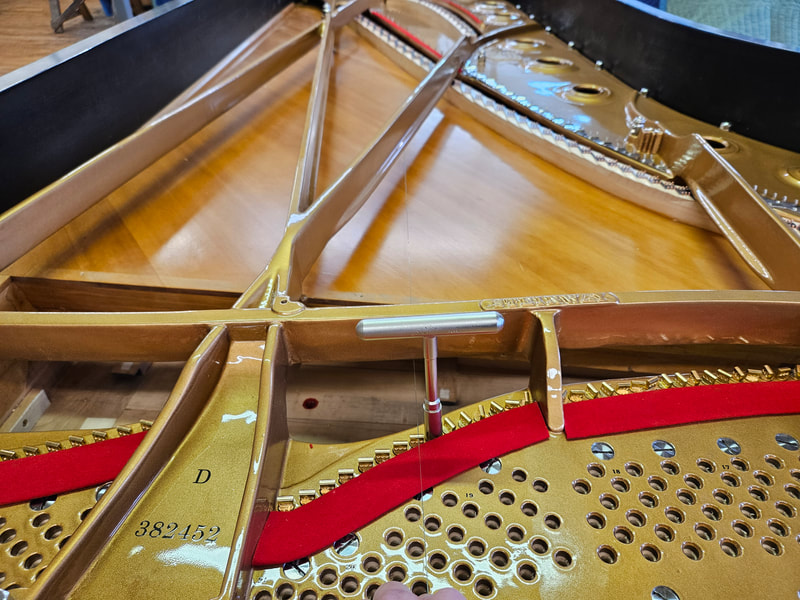|
First align agraffes. Run a fish line or plastic thread from bridge pins to tuning pins, turn agraffes till tight and top surface 90 degrees to the line. Set up for stringing. We use spools of strings of different sizes from # 21 to #13. Place soundboard protection in case strings scratch the soundboard. Jack up pinblock with pinblock support like this. Thread string through agraffe, use coil makers to make a three round coil on tuning pins, pound down tuning pin. Run string through bridge pins, around hitch pin, and back through next agraffe or agraffe hole. Sometimes the string needs a little help to go onto counter bearing felt like in picture on the right. Cut string to length, make three round coil, pound down tuning pin, and check the pin is down to 1 inch. The one loop is fastened now. Lift string with a string lifter while turning and pulling it to tension. Tighten the coils with a coil lightener. Squeeze the becket tight. For single hitch pin loop string, wrap string around a fastened demi hitch pin. The jig for making the loop is homemade. Thread string through the hole on jig, push the string tail against screw top on jig, turn the top loop with a plyer. The loop is make with ease. Before bass strings are on, wave string braces at tenor section. It will be difficult trying to do so with bass strings in the way. Set up for bass strings. Carefully read the instruction from manufacture, especially how many turns and which direction to turn the strings before pounding pins in. Most bass strings need to be bent a little at tip in order to go through agraff on to counter baring felt. Double check the winding direction of copper winding, turn string the same direction 1 or 2 turns according to instruction, then pound tuning pin in. When space is too tight to use air pounder, a tuning pin punch and hammer will be used. Make sure not to miss hitch pins while putting strings on. Be patient till the last string is finished. Wave in string braces. Next is treble string spacing. There are no agraffes here so spacing is done according to the action/hammer spacing. Jack up the scale stick, made from action, against strings. Support strings with a string spacer, hammer it to the left or right till mid string settles right on the mark on scale stick. The unison width at treble shall be the same with agraffe section. The jig copies width from agraffes. Use it to measure treble unisons. Use a non-sharp/dull screw driver to move strings if needed. It is best done before any chip tuning. When strings are at high tension, moving them will be very hard. Chip tune piano to pull strings to tension, even out tuning pin height at about 7/8", use a straight edge to check pin evenness. Tighten coils and beckets one more time. Chip tune again. Stretch strings, make sure all strings are on the counter baring and well spaced. Chip tune for the 3rd time, then settle/tap down strings at hitch pins and bridge pins.
Comments are closed.
|
Archives
May 2024
|




















































